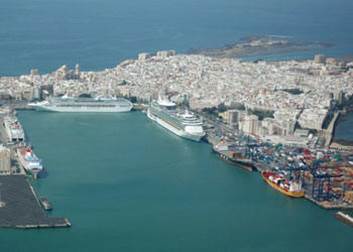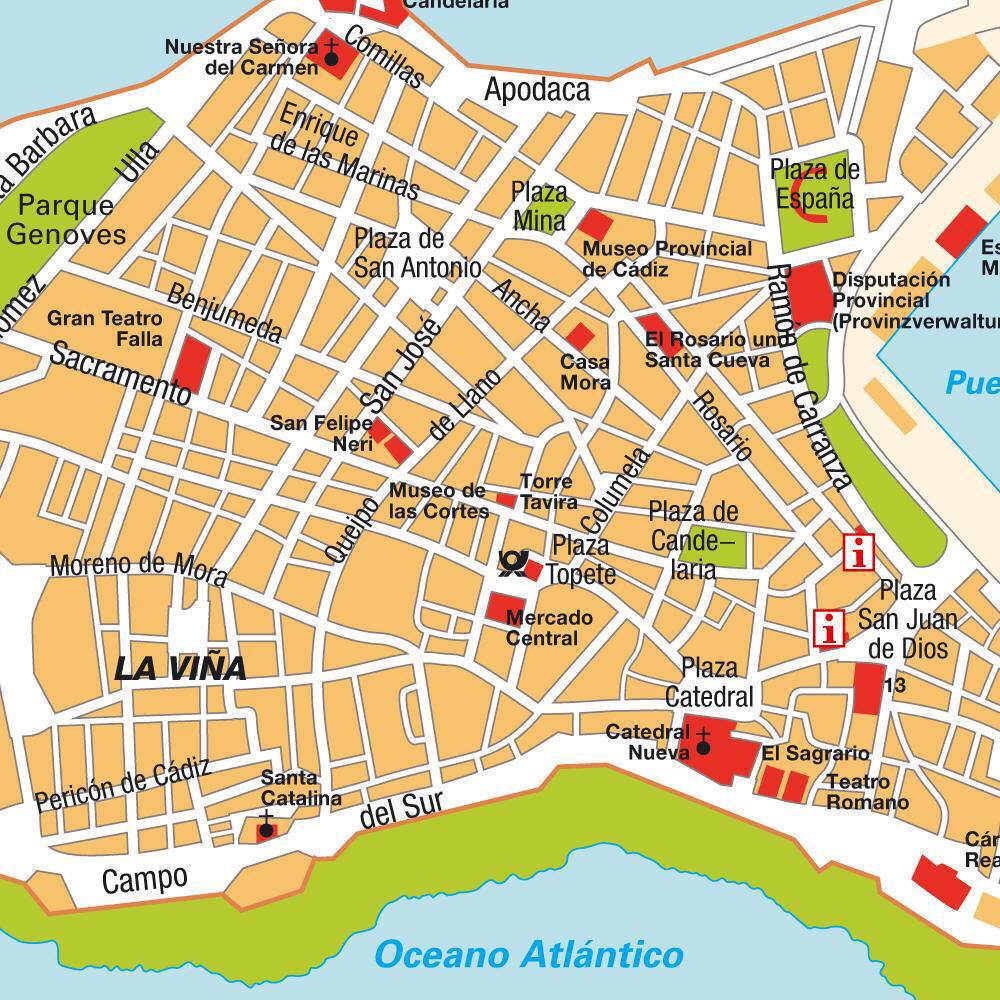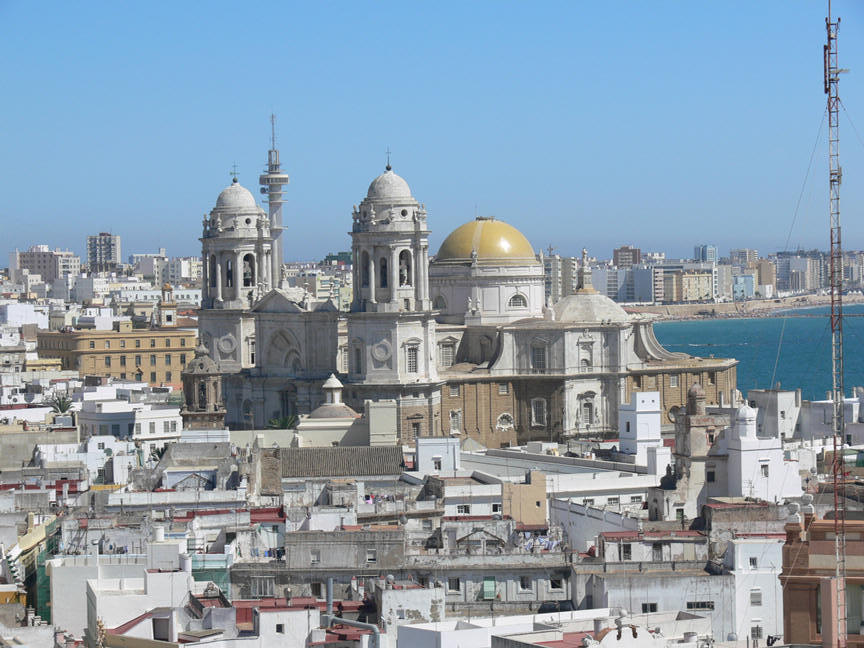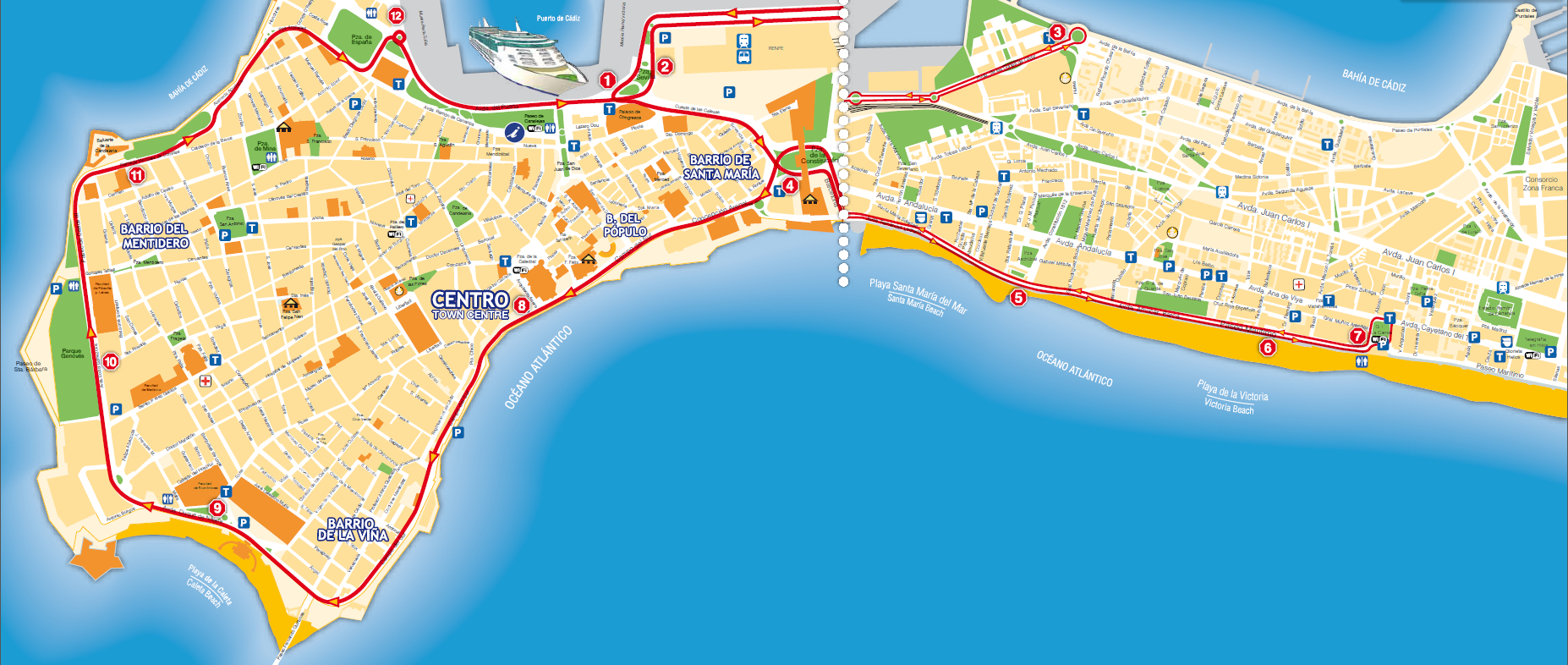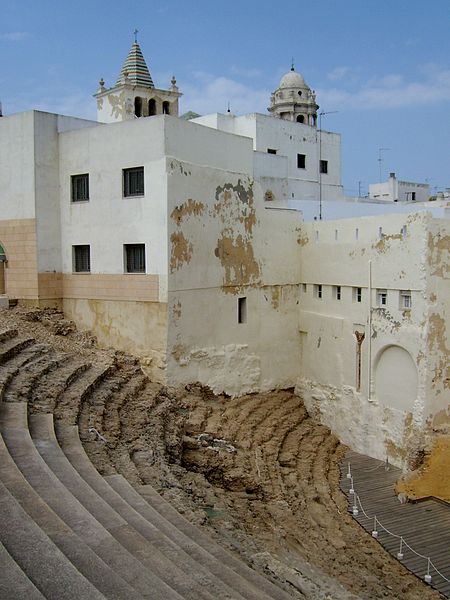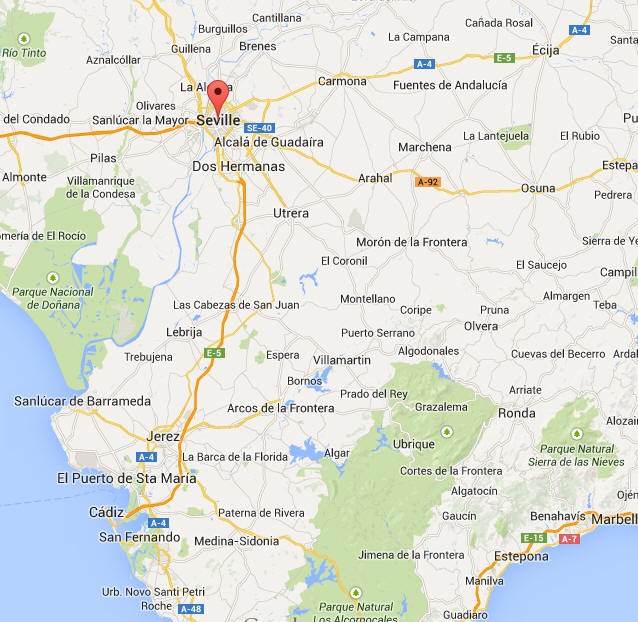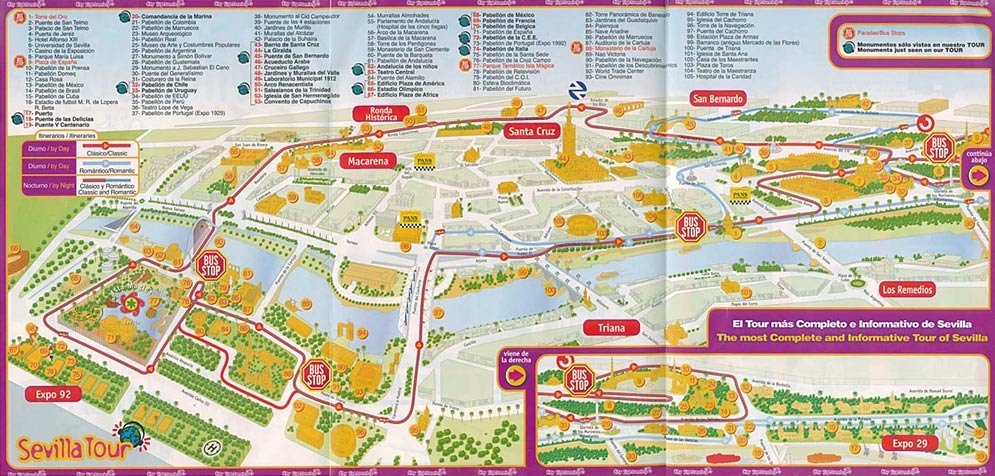Cadiz, Spain
May 11 (Sunday) - Cadiz, Spain (9:00-6:00)
Booked April 23

Cadiz to Seville
77 miles - 80 minutes
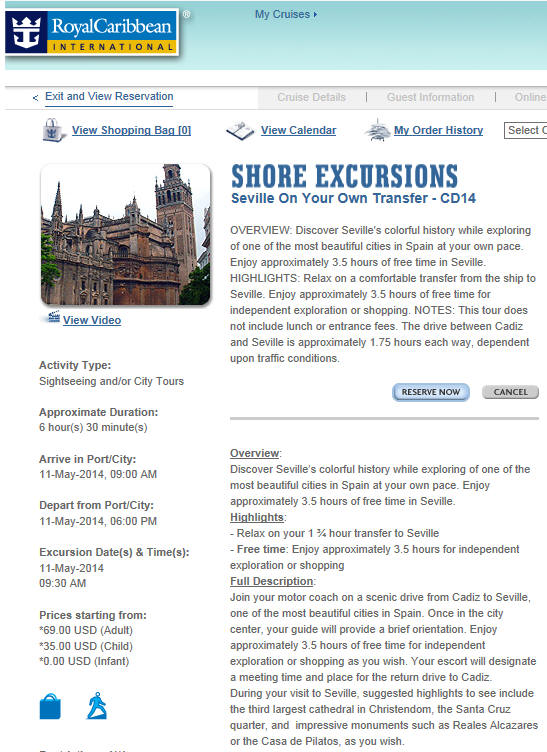
Seville
Seville Landmarks
The Giralda The Cathedral of St. Mary was built from 1401–1519 after the Reconquista on the former site of the city's mosque. It is among the largest of all medieval and Gothic cathedrals, in terms of both area and volume. The interior is the longest nave in Spain, and is lavishly decorated, with a large quantity of gold evident.
The Alcázar facing the cathedral was developed from a previous Moorish Palace. Construction was started in 1181 and continued for over 500 years, mainly in the Mudéjar style, but also in the Renaissance style.
The Torre del Oro was built as a watchtower and defensive barrier on the river. A chain was strung through the water from the base of the tower to prevent boats from traveling into the river port. The City Hall was built in the 16th century in high Plateresque style by master architect Diego de Riaño. The façade to Plaza Nueva was built in the 19th century in Neoclassical style.
The Palace of San Telmo, formerly the University of Sailors, and later the Seminary, is now the seat for the Andalusian Autonomous Government. It is one of the most emblematic buildings of baroque architecture, mainly to its world-renowned churrigueresque principal façade and the impressive chapel.
The Royal Tobacco Factory is housed on the original site of the first tobacco factory in Europe, a vast 18th century building in Baroque style and the purported inspiration for the opera Carmen.
The Metropol Parasol, in La Encarnación square, is the world's largest wooden structure.[28] A monumental umbrella-like building designed by the German architect Jürgen Mayer, finished in 2011. This modern architecture structure houses the central market and an underground archaeological complex.
The terrace roof is a city viewpoint.[29] The General Archive of the Indies, is the repository of extremely valuable archival documents illustrating the history of the Spanish Empire in the Americas and the Philippines.
The building itself, an unusually serene and Italianate example of Spanish Renaissance architecture, was designed by Juan de Herrera.
The Plaza de España, in Maria Luisa Park (Parque de Maria Luisa), was built by the architect Aníbal González for the 1929 Exposición Ibero-Americana. It is an outstanding example of Regionalist Revival Architecture, a bizarre and loftily conceived mixture of diverse historic styles, such as Art Deco and lavishly ornamented with typical glazed tiles.
The neighbourhood of Triana, situated on the west bank of the Guadalquivir River, played an important role in the history of the city and constitutes by itself a folk, monumental and cultural center. On the other hand, La Macarena neighbourhood is located on the northern side of the city center. It contains some important monuments and religious buildings, such as the Museum and Catholic Church of La Macarena or the Hospital de las Cinco Llagas.
Cadiz
Fishing, commerce
and tourism provide Cádiz with its main sources of income. It's main ports are
Cádiz, San Fernando, Puerto Real, Puerto de Santa María, Chiclana and Algeciras.
In recent years Cádiz has grown in popularity as a holiday destination
especially among families seeking good weather, wonderful long sandy beaches and
fewer crowds than the nearby and busier Costa del Sol. As a result the number of
hotels, apartments and other services has risen over the past few years, and the
standard is generally very good indeed. Cádiz is also very popular with surfers,
as it is one of the few places in Spain to offer great weather and high waves.
And for visitors who want to explore the province, the white villages dotting
the inland mountains are beautiful.
History of the province of Cádiz.
Cádiz is considered to be the oldest Western city due to its strategic location
on the coast dividing Europe and Africa. It has been occupied several times over
its history and there is some evidence to suggest that Cádiz was a Fenecian
settlement around 1000 B.C. and that it formed part of the Fenecian trade route
to the Atlantic. Later on came the Greeks, the Cartagens and then the Romans.
From the 8th century onwards it was taken over by the Moors. The in the 11th
century Alfonso X took control of the province reconverting it to Christianity.
In the 13th century Cádiz gained importance as the place where Christopher
Columbus set sail from on his discovery voyage to America.
The city wall and its entrances which surround the old part and many of its
ancient monuments were built by Cristóbal de Rojas in the 17th century. Thanks
to him the first plan of the city was drawn up in 1609. In 1713 following the
treaty of Utrecht, Spain handed over Gibraltar to the British.
During the 17th and 18th centuries Cádiz grew rapidly due to its trade with
Amercia and the liberalisation of commerce. Sherry made in nearby Jerez began to
be exported all over the world. And it was during the 18th century, known as the
'golden century' that Cádiz monopolized sea trade. In 1812, during the French
occupation, the Cádiz parliament met and the first Spanish Constitution was
written converting Cádiz into the political centre of Spain.
What to do and see in Cádiz
Walks : Cádiz is a port city with grand avenues, squares and gardens so just
strolling around is a good way to soak up the atmosphere and get a feel of the
place.
Palaces and Castles in Cádiz:
Puerta Tierra: Part of the city wall with two fortifications (San Roque y el de
Santa Elena), built in the 18th century. The city entrance is in the middle of
the wall.
San Sebastián castle: This is a building located on the small island off la
Caleta beach. It was built in 1706 as a fort to defend the northern side of the
city.
Santa Catalina Castle: This is a 17th century building built for defensive
purposes to defend the northern side of La Caleta beach. It is now used as an
exhibition centre and concert hall.
Baluarte de la Candelaria: This is a fort located in Cádiz bay. Built in 1672.
Torre Tavira: c/Marqués del Real Tesoro, 10. Located in the upper part of
Cádiz's it has a good view of the horizon. It is now an exhibition centre. The
room called the Cámara Oscura is particularly interesting.
Teatro Romano: Cádiz's roman theatre which was only discovered in 1980. Located
in the area known as the Barrio del Pópulo between the old Cathedral and the
Arco de los Blancos. It is thought to have been built in the 1st century B.C.
during the time of Julia Ceasar.
Baluarte de San Roque y Santa Elena: Two forts located on either side of the
city entrance in the city's wall.
Arco de los Blancos: Located next to the old Cathedral in the area known as the
barrio de Pópulo. This is the Western entrance to the city built by Alfonso X el
Sabio in the 13th century.
The old Cathedral: Located in the area known as the Barrio del Pópulo, next to
the Arco de los Blancos. Used as Cádiz's cathedral until 1838. It was built upon
an ancient mosque under the orders of Alfonso X el Sabio. Destroyed various
times over its history, only the vault and entrance remain.
Nuestra Señora del Rosario and Santo Domingo de Guzmán Church: A temple built in
the 17th century by Antón María Calafate and Bartolomé Ruíz. It was reformed in
1666 by Luis de Lojo. It was restored in the 20th century. The marble altar is
particularly interesting.
Nuestra Señora de los Remedios del Convento de San Francisco Church: Founded by
the Franciscan order in the 16th century.
San Agustín Church: Founded by the Augustinos in 1617 - neoclassic style.
Oratorio de San Felipe Neri Church: Located in the Plaza San Felipe Neri. 17th
century church which during the French occupation was the place where Cádiz's
parliament met. It is the place where the first Spanish constitution was written
in 1812. Its walls are adorned with plaques commemorating those who took part in
drawing up the constitution. Some of the members of Cádiz's parliament are
buried in the crypt. There is an interesting painting by Murillo.
Oratorio de la Santa Cueva Church: c/ del Rosario, E. This is a small chapel in
a neoclassic style. It has 3 paintings by Goya.
La Palma Church: Located in the area known as the Barrio de la Viña. Built in
the 18th century in a baroque style.
San Antonio de Padua Parish Church: Built in the 17th century and remodelled in
the 19th century in a baroque style.
Nuestra Señora de las Angustias, del Caminito Church: A beautiful chapel, built
in 1701, located in the old part of Cádiz on a cliff edge. It offers some
wonderful views.
Museums in Cádiz:
The Archeological Museum: Located in the Plaza de Mina in a 19th century
building by Juan Daura
Real Academia de Bellas Artes Museum: Located in the Plaza de Mina. It houses a
collection of Fenecian and Roman art. it has a sarcophagus and Spanish 17th to
19th century art mainly by Murillo and Zurbarán.
The Municipal Museum: c/Santa Inés/ next to junto San Felipe church. This museum
covers the city's local history very well.
Cádiz Museum: Located in the Plaza de Mina built by Juan Daura. The museum has 3
sections: Archeology, Bellas Artes and Ethnology.
Other interesting Buildings in Cádiz:
Aramburu House: c/ Veedor, 3. This is a 18th century palace built which was
restored in the later part of the 19th century.
Cádiz University Rector's Office: c/Atocha,16. Built at the beginning of the
19th century in a neoclassic style.
Palacio de la Diputación: Located in the former Customs building in the Port.
Built in 1765 by the architect Juan Caballero.
Balneario de La Palma: c/ Duque de Nájera, 3. This is where the Centre for
subaquatic archeology is based, it is located on La Caleta beach.
The Provincial Archives: Located in a 16th century building called Casa de las
Cadenas.
Parque Genovés: This park was created in the 19th century when the Paseo del
Perejil was expanded. It has many different species of trees brought over from
America.
Monument dedicated to the Cortes de Cádiz de 1812 (Cadiz Parliament): Located in
the Plaza de España. Designed by the architect Modesto López Otero and the
sculptor Aniceto Marinas between 1912 and 1929. It consists of 2 bronze statues
which represent peace and war and a central pillar where the text of the
constitution is written.
Shopping in Cádiz: Typical Cádiz products include wine, cold meats, cheese,
sherry, olive oil... The most important food markets are Mercado Central de
Abastos, la Merced and San José. There is also a lot of craftwork on offer such
as ceramics, furniture, blankets and ponchos.
Cádiz Province: It has 1,260 Kms of coast, of which about 200 Kms are beaches.
Cádiz is Spain's most southern province and covers an area of 7,385 kms with a
million inhabitants. The most outstanding features of this province are its
beaches and coastline with clean sparkling water.
There are many different types
of beaches from natural untouched coastline to more developed touristic areas.
It has an average temperature of 34ºc in summer with fresher temperatures at
night.
What to eat in Cádiz: Cádiz cuisine has clear Fenician, roman, arab and
colonical traits, and differs according to where you are. Delicious fresh
seafood, fish soups and rice dishes on the coast contrast with dishes made with
game, beef, goat, pork, river trout and vegetable-based stews inland. Try the
excellent hams and other pork products and local olive oil on offer in the
mountain villages.
Typical dishes from Cádiz include:
Coastal areas: Tortitas de Camarones (small thin crispy omlettes with tiny
prawns), calamares en su tinta (squid in its ink), fideos con gambas y almejas
(noodles with prawns and clams), all kinds of shellfish including sea urchin,
crab and lobster...
Inland: the local vinager and sherry produced in Jerez plays a key role in
dishes inland. Try la perdiz estofada (partridge casserole), revuelto de
esparragos trigueros (scrambled eggs with fresh asparragos), aceitunas aliñadas
(marinated olives), ajo caliente (warm garlic)...
Mountain villages: caldereta de cordero (lamb casserole), guiso de rabo de toro
(oxtail stew), wild game, esparragos trigueros (grilled asparragos).
Wine is very important to the local economy in the province of Cádiz and there
are important bodegas in Jerez de la Frontera, El Puerto de Santa María,
Sanlúcar de Barrameda y Chiclana de la Frontera.
Where to eat in Cádiz: These are some of the best restaurants in Cádiz: El Faro:
c/San Felix, 15, (Tel: 956 225 858): excellent sea food and tapas; La Leyenda,
Pº Marítimo, 20 (Tel.: 956 262 185): seafood and creative cuisine; Ventorrillo
El Chato, Vïa Augusta Julia (Ctra.Cádiz a San Fernando) Tel.: 956 250 025:
traditional andalusian cuisine with a modern touch; El Algibe, Plaza Plocia, 25,
(Tel.: 956 266 656): good locall dishes; El Balandro, Alameda Apocada, 22,
(Tel.: 956 220 992): imaginative dishes using local seafood; Doña Pepa, General
Muñoz Arenillas, 1 (Tel.: 637 215 818): regional cuisine, excellent fresh fish.
Where to stay in Cádiz: Click on
Cádiz hotel guide for a
review of the best hotels in Cádiz capital city and surrounding areas. See also
our selection of
cheap hotels in Cádiz for
comfortable hotels offering an excellent price: quality ration and
hotels in Jerez for nearby
alternatives.
What to see and where to visit in the Province of Cádiz:
Sports in Cádiz: Water sports such as sailing, windsurf and flysurf are popular
due to the fact that it is often very windy on the coast. Also a lot of people
enjoy fishing, diving and riding jet-skis. Hunting is also a popular pastime in
this province where there are 60 hunting reserves.
Golf is currently very popular. There are 21 golf courses in the province. In
general all of them are good and some are exceptional such as Sotogrande or
Montecastillo where major tournaments like the Ryder Cup take place (in Jerez de
la Frontera). Here is a selection of the best golf courses in Cádiz (click on
name for details):
Club de Golf Valderrama, Sotogrande,
San Roque Club Old Course (I),
San Roque Club New Course (II),
Montecastillo Resort, Jerez de la
Frontera,
Real Club de Golf Sotogrande, Sotogrande,
Cádiz
In the mountains you can do sports such as hand gliding, bungee jumping,
cycling, pot holing and horse riding. There are many horse riding schools
throughout the province. In Jerez de la Frontera there is a famous motorbike and
car racing circuit.
Ruta de los Pueblos Blancos (white villages route): These white villages located
towards the north of the Province are mountain villages made up of small white
houses. These villages normally have Roman or Moorish archeological remains.
This area has been declared a Biosphere heritage site by UNESCO. There are 19
white villages, the most interesting being:
Grazalema: The rainiest place in Spain.
Arcos de la Frontera: It has a lovely parador hotel clinging on to the side of
the mountain, lots of winding streets and monuments
Bornos: Visit Castillo de Fontanar and its renaissance gardens.
Algar
Espera: Visit the remains of Roman city Carisa Aurelia , 2 Roman necropolis, the
wall and a mausoleum (2nd- 4th century).
Algodonales: This one of the entrances to the Grazalema National Park.
Villamartín: El Dolmen de Alberite a megalithic monument dating back 6000 years.
Puerto Serrano: Mountain sports: horse riding and hiking.
Olvera: Declared a historical and artistic centre.
El Gastor:
Setenil de las Bodegas: Village with houses built in spaces between the stones
caused by river erosion.
Torre Alhámique: A Nazarite fort fortaleza nazarí de la que se conserva la
muralla
Grazalema National Park: You can visit the villages El Bosque, Benaocaz,
Villaluenga del Rosario and Ubrique.
Ruta de pueblos Romanos (Roman villages route): You can take two routes, one in
the interior and one on the coast. Some of the villages also form part of the
white villages route.
Roman route on the coast: Cádiz, San Fernando, Chiclana, Conil, Veger, Barbate,
Zahara de los Atunes, Tarifa and Algeciras.
Roman route in the interior: Medina Sidonia, Paterna de Rivera, Arcos de la
Frontera, Espera, Bornos, Villamanrique, Prado de Rey, El Bosque and Ubrique
Jerez de la Frontera: This city is recommended for its charm, elegance and
historical monuments. It has Palaeolithic origins and other cultures such as the
Fenecians, Romans and especially the Moors have also left their mark on the
city. Located in the middle of countryside, 28 kms from Cádiz, there are many
things which make this an attractive place to visit: the old part which was
declared a historical artistic centre, the famous riding school, the motorbike
and car racing circuit and wine cellars.
Places of interest along the coast of Cádiz
Sanlúcar de Barrameda: 18th century botanic gardens designed José Celestino Muti.
Located on the Guadalquivir estuary at the entrance to the Doñana national park
(considered to be the most important nature reserve in Spain).
Chipiona: Village popular with summer tourists with 4 beaches and good
facilities.
Rota: Two excellent beaches: Punta Candor and la Almadraba
Puerto de Santa María: Located in Cádiz bay. A lot of historical sites: San
Marcos castle (10th century), Prioral Mayor church (15th century) and a
bullring. The best beaches are: La Puntilla, Valdelagrana, Fuentebravía, Puerto
Sherry and la Caleta Real. Busy in the summer, good bars and restaurants.
Puerto Real: Fishing and industrial city
San Fernando: Known as "La Isla", salt marshes and sea.
Chiclana de la Frontera: Salt marshes, pine forests and 9 kms of beaches. La
Barrosa, located in the tourist resort of Novo Sancti Petri, is one of the best
beaches in the province. Sancti Petri: tourist resort with lots of hotels,
chalets, apartments, restaurants and sports facilities: golf, horse riding,
sailing, water skiing, diving...
Conil de la Frontera: Fishing village with 14 kms of beaches. Good nightlife.
Vejer de la Frontera: Medieval village with some Moorish remains located on top
of a hill. Nearby beaches are:Trafalgar and El Palmar.
Barbate: Santiago castle. Touristic fishing village with beaches: Carmen,
Yerbabuena and Caños de Meca.
Zahara de los Atunes: Touristic fishing village.
Tarifa: Good for water sports: windsurfing, sailing... beaches:Bolonia, Los
Lances, Punta Palomas, La Plata, Valdevaqueros and Torre de la Peña.
Algeciras
San Roque-La Linea-Sotogrande: Beaches: Torreguadiaro, San Roque, Guadalnilón
(virgin beach with sand dunes), El Cabrero (virgin beach with sand dunes),
Torrecarboneras (virgin beach).
Sotogrande: Exclusive beach belonging to the Sotogrande complex. Good for water
sports. Polo championships. It also has one of the best golf courses in the
province (Valderrama).
National Parks in Cádiz: There are 5 National Parks in Cádiz province covering
200,000 hectares of forests, wetlands, beaches and salt marshes.
Doñana National Park: Avda. de Bajo de Guía en Sanlúcar de Barrameda, Tel: 956
36 07 15 - 3,400 hectares. Considered to be the most important nature reserve in
Spain.
La Bahía de Cádiz National Park: Callejón Cohegen, 13, San Fernando, Tel: 956 88
24 11 - 10,000 hectares of dunes, canyons, cliffs. Beaches: Abarcs Sanlúcar de
Barrameda and Trebujena.
La Breña and Marismas de Barbate National Park: Tel: 956 59 00 71 - with its
4,737 hectares this park covers an area from Barbate to Vejer. You can go
cycling, hiking and bird watching here.
La Sierra de Grazalema National Park:36,000 hectares. You can do lots of
mountain sports here such as hiking, horse riding, cycling and pot holing as
well as activities like bird watching.
Los Alcornocales National Park: 170, 205 hectares (161,000 are in Cádiz). This
is the largest area in Europe with cork oak trees. You can do lots of sports
here such as hiking, abseiling, canoeing, cycling and more. The mountains here
are rich in flora and fauna you can also find some caves with cave paintings
dating back to the neolithic period.
RCL Excursions
